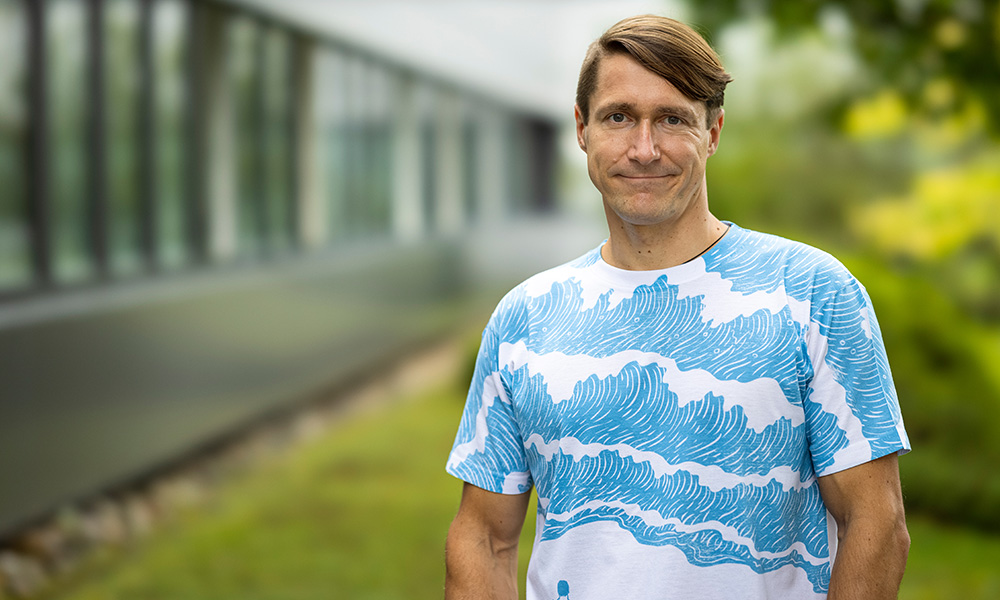SpaceM reveals metabolic states of single cells
Nature Methods 5 July 2021
10.1038/s41592-021-01198-0
Identifying the molecular differences between healthy and unhealthy cells could be used to switch ‘bad’ cells to ‘good’

Theodore Alexandrov is excited. As he begins to speak, there’s a kind of fervour about him. He’s created a tool that he hopes will change the way we think about medicine.
To cure disease, doctors aim to restore unhealthy cells back to health, re-establishing balance in the organism. But this requires some way of measuring when cells switch between these states – going from ‘good’ to ‘bad’ or back again.
Alexandrov has spent the past seven years as a team leader at EMBL Heidelberg, leading the development of a technology that can identify the cellular changes between healthy and unhealthy cells. The result is SpaceM, an open-source method for detecting metabolites – all the small molecules that provide cells with the energy and raw materials they need to function.
While not a rocket heading to outer space, SpaceM could help researchers explore new frontiers. The method can identify pivotal changes in a cell’s metabolites, creating a comprehensive molecular profile that pinpoints a cell’s healthfulness.
This information has the potential to transform drug discovery and precision medicine. “To aid drug discovery, we can apply a drug directly to the cells at the point when the cells ‘go bad’ to determine if cells react to the drug treatment,” Alexandrov said. “But also, we create an opportunity for drug development that goes beyond what is done now – to fine-tune drugs so they restore cells’ native, healthy states.”
Pioneered by PhD student Luca Rappez, SpaceM is the result of a joint effort by scientists with expertise in deep learning, cell biology, metabolomics, bioinformatics, and mass spectrometry. The method combines light microscopy and imaging mass spectrometry (a technique that allows scientists to identify and measure the amounts of a cell’s molecular building blocks, including metabolites and lipids).
Measuring the amounts of various molecules indicates a cell’s condition and whether it is healthy – similar how biomarkers like low-density lipoprotein (LDL) cholesterol identify cardiovascular disease risk, or high-serum creatinine is a marker of kidney impairment.
Alexandrov’s team confirmed the role of these metabolic biomarkers in experiments: feeding excess lipids to a cell under stress, for example, changed its metabolic profile drastically. Interestingly, the biomarkers in these cells strongly resembled those of patients with fatty liver disease. With SpaceM, the scientists could capture and track, step-by-step, the changing metabolic states of single cells.
Their open-source method, which was published in July in Nature Methods, can be applied to many different cell types. The Alexandrov team is looking specifically at cells involved in metabolic diseases and prostate cancer.
“When we talk about metabolic disease, we start with NAFLD and NASH,” Alexandrov said, referring to non-alcoholic fatty liver disease (NAFLD) and non-alcoholic steatohepatitis (NASH). These conditions are caused by fat build-up in the liver and can lead to fibrosis and liver cancer. Common in overweight people or who have diabetes, NASH does not worsen in all patients. However, neither NAFLD nor NASH have approved pharmacological treatments.
In collaboration with Professor Mathias Heikenwalder from the Germany Cancer Research Centre (DKFZ), Alexandrov’s team used SpaceM to examine the metabolic processes in individual liver cells, looking at both NASH cells and neighbouring healthy cells to decipher when cells go ‘bad’.
“The NASH cells actually look healthy, and their phenotype may not have changed from the outside, but on the inside, their metabolic reactions have already been reprogrammed,” Alexandrov explained. “Ultimately, their metabolism is working differently – accumulating more lipids – and this is reflected in the markers.”
The information generated by SpaceM could ultimately help to create therapeutics that fully restore the cells’ correct metabolic programming, and the method has other advantages.
“SpaceM can generate data on a scale hardly possible using other approaches, scanning millions of cells overnight,” Alexandrov said. “It can tell when ‘good’ cells turn ‘bad’ better than microscopy, yet it is cheaper and faster than many alternatives.”
Recently, the team started collaborating with researchers at the University of Bern and IBM Research in Zurich to apply SpaceM to personalised therapy for prostate cancer.
Prostate cancer is the second most common cancer in men, and few therapies exist. Dr Marianna Kruithof-de Julio, a research group leader from the university, has established a global network of physicians treating prostate cancer patients. The physicians send cells from their patients to Kruithof-de Julio, who grows them into prostate cancer organoids – 3D clusters of cells resembling prostate tumours. She can then treat the organoids with candidate drugs to test their efficacy.
Previously, the researchers would count how many cells the drugs killed. But that’s not enough, because even a few surviving cells can initiate cancer relapse.
“It would be more beneficial to return all cells to a healthy state,” Alexandrov said, “or at least to know what is going on inside the surviving cells.” He is working with Kruithof-de Julio to determine whether single-cell metabolomics, and SpaceM, can provide this information. If it can, then physicians might be able to use the method to select therapies that offer the least chance of relapse.
In the future, this approach could also lead to novel therapies that instead of just killing tumour cells would restore them to a metabolic state most similar to that of healthy cells. Alexandrov believes this could potentially add 10–15 years to patients’ lives.
“In this new field, we often walk in darkness where every step requires lots of effort and caution. This is very high-risk, but high-reward,” Alexandrov said. “But if we can succeed at reprogramming cell metabolism to transform ‘bad’ cells to ‘good’, we may change current medicine.”
Watch a short video explainer here about Alexandrov’s research.
Nature Methods 5 July 2021
10.1038/s41592-021-01198-0